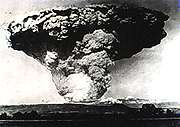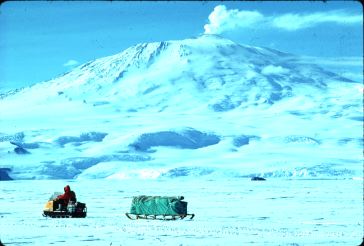

 Lithosphere
Lithosphere
Volcanoes Volcanoes
spew particulate matter and aerosols into the stratosphere. Sulfate aerosols from volcanoes appear to play an important natural
role in ozone depletion. Sulfur dioxide (SO2) reacts with water to form sulfuric acid (H2SO4) in an aerosol form.
Results include the reflection of incoming solar radiation and the conversion of inactive
chlorine species such as HCl and ClONO2 to more active types. In this way, these aerosols act much like the polar
stratospheric clouds with reactions occurring on their surfaces. The resultant active
chlorine species, such as ClO and Cl, readily react with and destroy ozone. Photo: Courtesy of NGDC/NOAA.
Reaction described by McCormick, Thomson, & Trepte (1995) in Nature 373:399-404
After the eruption of Mt. Pinatubo in 1991, some scientists predicted a 12% decrease in ozone for the winter of 1992-1993. A 15% decrease actually resulted. They also predicted that the antarctic polar vortex would last longer, and there is some evidence that it did.
Volcanic plumes contain sulfate aerosols, which play a large natural role in ozone depletion. Included in these aerosols are large amounts of hydrogen chloride (HCl). Some scientists argue that the amount of chlorine put into the stratosphere by a major volcanic eruption rivals that of anthropogenically produced chlorine.
In the 1980s, emissions of CFCs added chlorine at the rate of 1 Mton per year to the atmosphere. This resulted in an increase of 0.3 Mton per year in the stratosphere. High-end estimates of the amount of chlorine spewed into the atmosphere by a major volcanic eruption ranged from 0.1 to 1 Mton. Eruptions such as El Chicon in 1982 and Pinatubo in 1991 were sufficiently powerful for their plume to reach 25 km, well into the ozone layer. However, the amount of chlorine added to the stratosphere by El Chicon was only 0.04 Mton, and the amount added by Pinatubo was even less. These amounts were much lower than the high-end estimates because the volcanic plume contains 1000 times as much water vapor as it does HCl. The HCl readily dissolves in water and rains out within a few days.

Mount Erebus from Windless Bight on the Ross Sea, showing a
distinctive plume.
Photo: Philip Kyle
Mt. Erebus, an antarctic volcano, was identified by some early researchers as playing a role in creating the ozone hole. During its most active period, the late 1970s and early 1980s, it contributed about 0.06 Mton of chlorine per year to the atmosphere. In 1991, this figure was only 0.013 Mton. The plume of Mt. Erebus reaches about 0.5 km above the volcano, which is at a height of 3794 m. Even though the tropopause is very low and weak (if it exists at all during the antarctic winter) it is unlikely that much of the chlorine from the plume reaches the stratosphere.
The general conclusion is that volcanically-produced sulfate aerosols have a destructive effect on ozone, but that volcanically-produced chlorine is of minor importance. Details and references on chlorine, and volcanoes.
|
[ Glossary ] [ Related Links ] [ PBL Model ] [ Home ] [ Teacher Pages ] [ Modules & Activities ] |
HTML code by Chris Kreger
Maintained by ETE Team
Last updated April 28, 2005
Some images © 2004 www.clipart.com
Privacy Statement and Copyright © 1997-2004 by Wheeling Jesuit University/NASA-supported Classroom of the Future. All rights reserved.
Center for Educational Technologies, Circuit Board/Apple graphic logo, and COTF Classroom of the Future logo are registered trademarks of Wheeling Jesuit University.